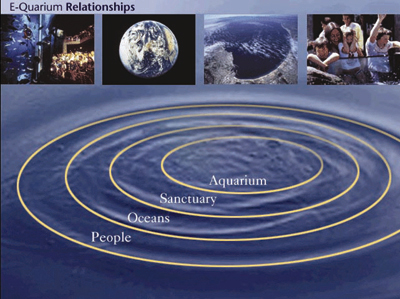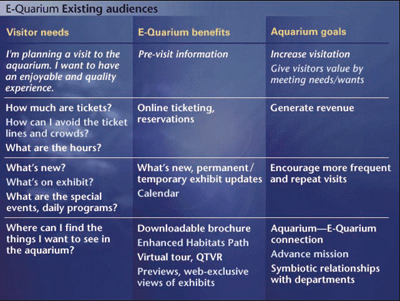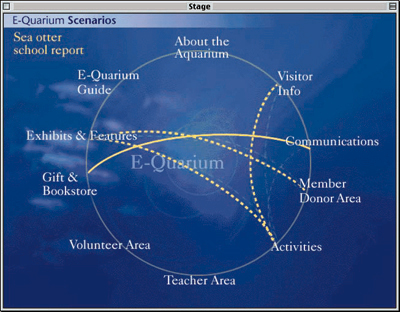![]()
![]()
![]()
![]()
![]()
![]()
![]()
![]()
![]()
![]()
![]()
![]()
![]()
Archives
& Museum Informatics
158 Lee Avenue
Toronto, Ontario
M4E 2P3 Canada
info@ archimuse.com
www.archimuse.com
|
|
Search A&MI |
Join
our Mailing List.
Privacy.
Published: March 15, 2001.

Envisioning the E-Quarium: Strategic design planning for the Monterey Bay Aquarium's web site
Lauralee Alben, AlbenFaris Inc., Michael Rigsby, Monterey Bay Aquarium, USA
Abstract
This presentation focuses on the strategic design planning and vision creation process for the E-Quarium, the online complement to the Monterey Bay Aquarium. More than six months of informed investigation and analysis resulted in an ambitious redesign of the web site, which launched in October 1999. The aquarium and AlbenFaris worked in close partnership in a collaborative development process that included visitor research, establishment of a clear strategic vision, a set of goals and content objectives, identification of target audiences, scenario planning, competitive analysis, site definition and design. As a result, the new E-Quarium exemplifies the relevance of grounded design practice.case study, this is a thoughtful weaving of the process, perspectives and experiences the designers gained from understanding the aquarium's structure, mission and culture and the needs of the aquarium's key audiences. The inclusion of experts in marine biology and conservation, exhibition design and technology as members of the development team provided inspiration and insights beyond the normal boundaries of interactive design. This presentation is also a journey into the wonder of kelp forests and the deep sea-habitats showcased in the aquarium exhibits and the online E-Quarium. Both the physical aquarium and the E-Quarium have a profound effect on visitors, inspiring and informing them about the wonders of the oceans. And both serve as catalysts, making visitors aware of ocean conservation issues and encouraging them to join with the Monterey Bay Aquarium in the cause of ocean conservation.Keywords Strategy, web site, visitor research, interactive design, scenario planning, goal planning, collaborative design, multimedia, competitive analysis, online surveys
INTRODUCTION
Widely acclaimed as the most innovative aquarium in the world, the Monterey Bay Aquarium was founded in 1978 by marine biologists and Hewlett-Packard co-founder David Packard. With a mission to inspire conservation of the oceans, the aquarium maintains cutting-edge conservation research programs for threatened sea otters and for bluefin tuna and other open ocean fishes. Since 1984, it has attracted more than 27 million visitors and has set attendance records among U.S. aquariums. It has pioneered living exhibits of jellies, open ocean animals and deep sea creatures. Aquarium education programs welcome more than 90,000 students and teachers each year.
In late 1997 the Monterey Bay Aquarium committed to a major redesign and expansion of its existing E-Quarium web site. In developing new projects, the aquarium places a high value on both internal teamwork and involving visitors in the design process by identifying and meeting their needs and expectations. For this project, the aquarium selected AlbenFaris Inc. as its design partner because of their high-quality interaction design and because it recognized them as a firm with whom the aquarium could work in a close, collaborative partnership. This partnership, along with efforts of a large team, launched the new E-Quarium in October 1999.
THE E-QUARIUM VISION
"People see us a trusted guide; they sense that we care. Let's find new ways to reach their hearts and minds and move them to become more connected with the oceans."
Julie Packard, Executive Director
A culmination of more than six months of intensive investigation
and analysis, the overall vision for the E-Quarium crystallized into an
inspiring context that informed the site design. The E-Quarium was designed
to become "Your Ocean Link"-a trusted guide to ocean information.
The E-Quarium reflects the aquarium's commitment to cutting-edge exhibits,
scientific accuracy and educational innovations. It also incorporates
the latest advances in web design and e-commerce.

Figure 1. Site vision and relationships
The vision statement called for the site to create relationships with visitors at several different levels. At its core, the site would connect visitors with the aquarium and with the aquarium's mission to inspire ocean conservation.
The Monterey Bay Aquarium is a regional aquarium, focusing on the marine life and marine conservation issues of the Monterey Bay National Marine Sanctuary (the largest and richest of the nation's protected marine areas.) Thus, the second ring of connection was to sanctuary. Beyond these waters lie the world's oceans, and, since the web site would have global reach, the next ring of connection would be to the greater oceans beyond Monterey Bay.
At the outer ring, tying together all the others, were the visitors themselves. Therefore, the goal was to design ways to make meaningful connections between our visitors and the ocean, visitors and the aquarium and among visitors themselves.
VISITOR NEEDS AND GOALS
"I am 11 years old. I have already written to the President about protecting dolphins because they are my favorite animals. He wrote me back saying that he would do something to help them. I love your aquarium so much that I went there to celebrate my birthday. I think you could make it even better though if you put a section where people could complain about any marine mammals that they think are being treated unfairly."
Leor Friedman, San Francisco
"We need to build a site that starts you out in third grade and then grows with you."
Steve Webster, Marine Science Advisor
The initial phase of the multiyear project involved creating a strategic plan that would guide the team through the development of the site. We began by conducting internal research at the aquarium. Through ongoing conversations with the aquarium's Internet Producer, and the extensive review of aquarium publications and documents, the designers became immersed in the aquarium's structure and culture. We then began a series of in-depth interviews with aquarium staff and volunteers to identify the desires, concerns and perceived opportunities of key departments and work groups.
From this research, we defined five main target audiences: children in grades K-12, their parents, K-12 teachers, adults age 25-55 without children, and aquarium members. Aquarium volunteers and members of the Press were targeted as secondary audiences.
Based on the audiences we wished to reach, we then began a period of visitor research. We created an online demographic survey to determine who was using the existing site, how they were using it and what features or content they would like or expect to find on the site. Concurrently, we conducted in-depth interviews with members of each audience group. We also reviewed two-year's worth of unsolicited visitor ideas, comments and suggestions from the existing site, to find commonalties in what our existing online audience was asking for. We then identified the strategic opportunities inherent in our findings.
Among the key demographic findings was that 30% of the visitors to the existing site were teenagers-one of our primary target audiences. This large percentage, despite fact that teenagers don't typically visit the physical aquarium, spoke to the tremendous opportunity for the new site. We also found that 56% of those in the survey had visited the aquarium between two and five times, while 27% had never visited the aquarium. These results pointed to both the possibilities of strengthening the bond with existing visitors and making them more deeply aware of and involved in marine conservation, as well as the opportunity to reach large numbers of new visitors.

Figure 2. Needs/benefits analysis
Based on staff interviews and the results of our audience research, we identified both key aquarium goals and visitors' needs. We then created a needs/benefits analysis to position the site content to best serve both the aquarium and its visitors.
SITE DEFINITION
"The aquarium is one of the best, well thought through, most complete exhibits of local marine biology that there could possibly be. The aquarium is at the top if its class and the web site should be too. The site is going to have to be wildly creative, innovative and technologically advanced to get me to visit it often."
Steve Shimek, marine biologist and aquarium member
During the site definition phase, we conducted an analysis of the aquarium's existing site and a competitive analysis of other aquarium, zoo, museum, and conservation sites, comparing content and technology. We identified areas of improvement for the new site and opportunities to extend the site beyond what others were currently offering.
We also looked at the aquarium's core values and brand identity, and the desirable attributes for the new site as expressed during aquarium staff interviews and matched these with the characteristic strengths of the web medium. From this, we created a list of design attributes for the site to guide us during later development. These included building a site that was informative, interactive, fluid, that could be kept current, and that could grow and evolve easily over time.
Informed by our visitor interviews, we mapped out four scenarios (one for each of the target audiences) to predict how visitors might interact and move through the site. These included a ten-year-old kid who visited the E-Quarium with his mom in order to research his sea otter report; an adult with out kids who was planning an aquarium visit; an aquarium member who visited the Member section and stayed up-to-date on the current events at the aquarium; and a teacher planning a unit on marine science and a field trip.

Figure 3. Visitor scenario planning
With the results of our research, we created a vision statement for the new site, detailed the scope of the project, and created a preliminary site architecture. We created several prototypes, conducted usability tests and a final design that continues to evolve today.
THE E-QUARIUM LAUNCH
In the presentation, we will also take a tour through the new E-Quarium, showing how the strategic design planning is reflected in the end result, and how both the site content and design are expressions of the vision statement.

Figure 4. Final web page design for habitats path
The design, informed by over one hundred and forty people from aquarium staff, members and volunteers as well as E-Quarium visitors from around the world, reflects our best attempts to meet everyone's needs and desires. If the E-Quarium e-mail is any indication, the site is reaching people's hearts and minds as they join with the Monterey Bay Aquarium in conserving the world's oceans.
"We are all feeling very happy and hopeful because we could find out there are still in our world people like you, that love life and work so hard and efficiently for its protection. Thank you for the beautiful feeling you gave us, and also for the great contribution to my children's education."
Carlos, Brazil

Figure 5. Final home page design for the E-Quarium
REFERENCES
The Monterey Bay Aquarium E-Quarium web site
